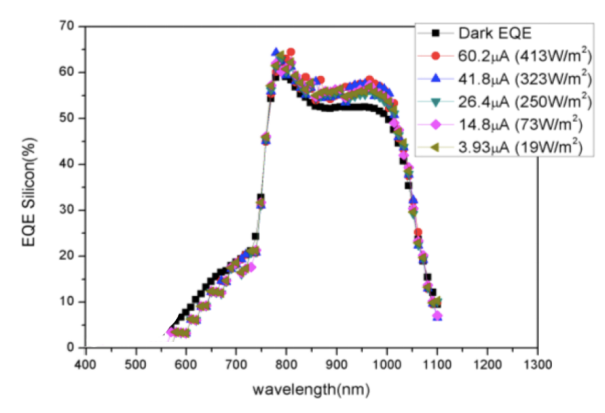
量子效率测试仪
PL/EL一体机
Sinton硅片少子寿命测试仪
Sinton硅块少子寿命测试仪
绒面反射率测试仪
3D共聚焦显微镜
清洗制绒工作站
在线四探针方阻测试仪
全自动扫描四探针方阻测试仪
在线薄膜厚度测试仪
晶化率测试仪
Horiba显微共焦拉曼光谱仪
傅里叶红外光谱仪
霍尔效应测试仪
分光光度计
全光谱椭偏仪
Horiba椭圆偏振光谱仪
TLM接触电阻率测试仪
超景深显微镜
网版智能影像测量仪
全自动影像测量仪
卧式拉力机
电池片稳态光衰老化试验箱
电池片紫外老化试验箱
电池片拉脱力综合测试仪
外观检验台
湿漏电测试系统
组件实验室EL测试仪
紫外老化试验箱
稳态光衰老化试验箱
电流连续性监测系统
PID测试系统
旁路二极管测试系统
LeTID测试系统
反向电流过载系统
脉冲电压测试系统
绝缘耐压测试仪
接地连续性测试仪
绝缘耐压接地测试仪
湿热环境试验箱
湿冻环境试验箱
热循环试验箱
动态机械载荷测试机
静态机械载荷测试机
冰雹冲击试验机
引出端强度试验机
霰弹冲击试验机
抗划伤(切割)测试机
剥离试验机
万能材料试验机(单臂)
万能材料试验机(双臂)
光伏玻璃透过率测试仪
醋酸测试试验箱
交联度测试系统
二极管接线盒综合测试仪
落球冲击试验机
半自动四探针
全自动探针式台阶仪
多通道太阳能MPPT系统
Horiba稳瞬态荧光光谱仪
钙钛矿P1激光划线测试仪
钙钛矿在线膜厚测试仪
钙钛矿工艺检测工作站
手持式IV测试仪
便携式EL测试仪
手持热成像测试仪
户外组件IV测试仪
户外组件多通道测试系统
光伏逆变器电能质量测试仪
无人机EL检测仪
新品发布|美能QE量子效率测试仪提升光伏电池性能的先进工具
日期:2024-07-08浏览量:10
量子效率(QE)测试仪是评估光伏电池性能的关键工具,特别适用于复杂的钙钛矿/Si叠层电池。该设备通过高精度的光源和先进的信号处理技术,确保测量的准确性和重复性。美能QE量子效率测试仪能够模拟自然光谱,适应不同的研究需求,并提供精确的量子效率值,是研究和工业应用的理想选择。

QE量子效率测试仪的工作原理
量子效率(Quantum Efficiency, QE)是衡量太阳能电池对入射光响应程度的一个重要参数,它反映了太阳能电池的光电转换能力。量子效率定义为收集到的电荷载体数量与入射光子数量之比。在太阳能电池的研究和应用中,提高量子效率是提升光电转换效率的关键。

QE光谱吸收阈值的Sigmoid波长和能量范围
量子效率测试仪(QE)是一种用于测量光电探测器在特定波长下的光电转换效率的设备。在量子效率测试仪的工作过程中,单色仪将来自光源的白光分解为具有不同波长的单色光。这些单色光接着通过斩波器转换成脉冲光。当这些不同波长的脉冲单色光照射到太阳能电池样品上时,电池会产生相应的脉冲光电流。接下来,使用锁相放大器来接收并放大这些微弱的脉冲光电流信号。为了进行精确测量,还需要测试一个已知量子效率值的标准太阳能电池所产生的脉冲光电流信号。通过比较这两个信号,我们可以精确计算出待测样品的量子效率值。这种方法不仅提高了信号的信噪比,还确保了测量的准确性和可重复性。

工作原理示意图
QE量子效率测试仪的系统在钙钛矿/Si 叠层电池应用
由于钙钛矿/Si叠层电池的结构特殊性,其QE测试需要分结进行,即照射一个偏置光,导通其中一个,使之成为导线,测试另一个。

光照条件的控制:根据,硅基-钙钛矿叠层太阳能电池的研究表明,通过合理的光吸收分配和光管理策略可以有效提高器件效率。因此,在进行量子效率测试时,应确保光源能够均匀覆盖整个测试区域,并且能够模拟自然光谱或其他特定光谱以适应不同的研究需求。
顶部钙钛矿测量:
顶部受光时,配850nm 长通滤片,调节最佳偏置光光强。偏置光强度较弱时,产生的光生载流子不足以填满陷阱,测量值偏小。
偏置光强度较大时,产生的光生载流子积累造成P区电子扩散系数增大,饱和电流密度增加,测得的EQE比真实小。

底部硅测量:
配550nm 短通滤片,顶部受光,调节最佳偏置光光强
由于载流子从顶部结转移到底部结, 顶部钙钛矿在光照下会有一个光生电压,这个电压对Si结的电流起阻碍作用,因此,须要在电压两端加偏置电压。在测试过程中须逐渐改变偏置电压,寻找最佳偏置电压点。
量子效率测试仪

联系:400-008-6690
兼容所有类型的光伏电池
四结电池测试(偏光/偏压模式)
EQE测量重复精度:
小光斑:300nm-400nm<0.5%;400nm-1800nm<0.25%
大光斑:300nm-400nm,1000nm-1800nm<1%,400nm-1000nm <0.5%;
反射率重复性:(小光斑):300nm-400nm<0.5%,400nm-1800nm<0.25%
短路电流密度重复性:<0.1%
光学稳定度≤0.2% @550nm
量子效率测试仪在光伏电池性能评估中扮演着不可或缺的角色。通过精确模拟自然光谱和利用先进的光电技术,该设备不仅能提供高精度的测试结果,还能适应各种复杂的电池结构,。随着光伏技术的快速发展,美能量子效率测试仪将继续为研究和产业界提供可靠支持,助力太阳能电池效率的持续提升和技术革新。




































































